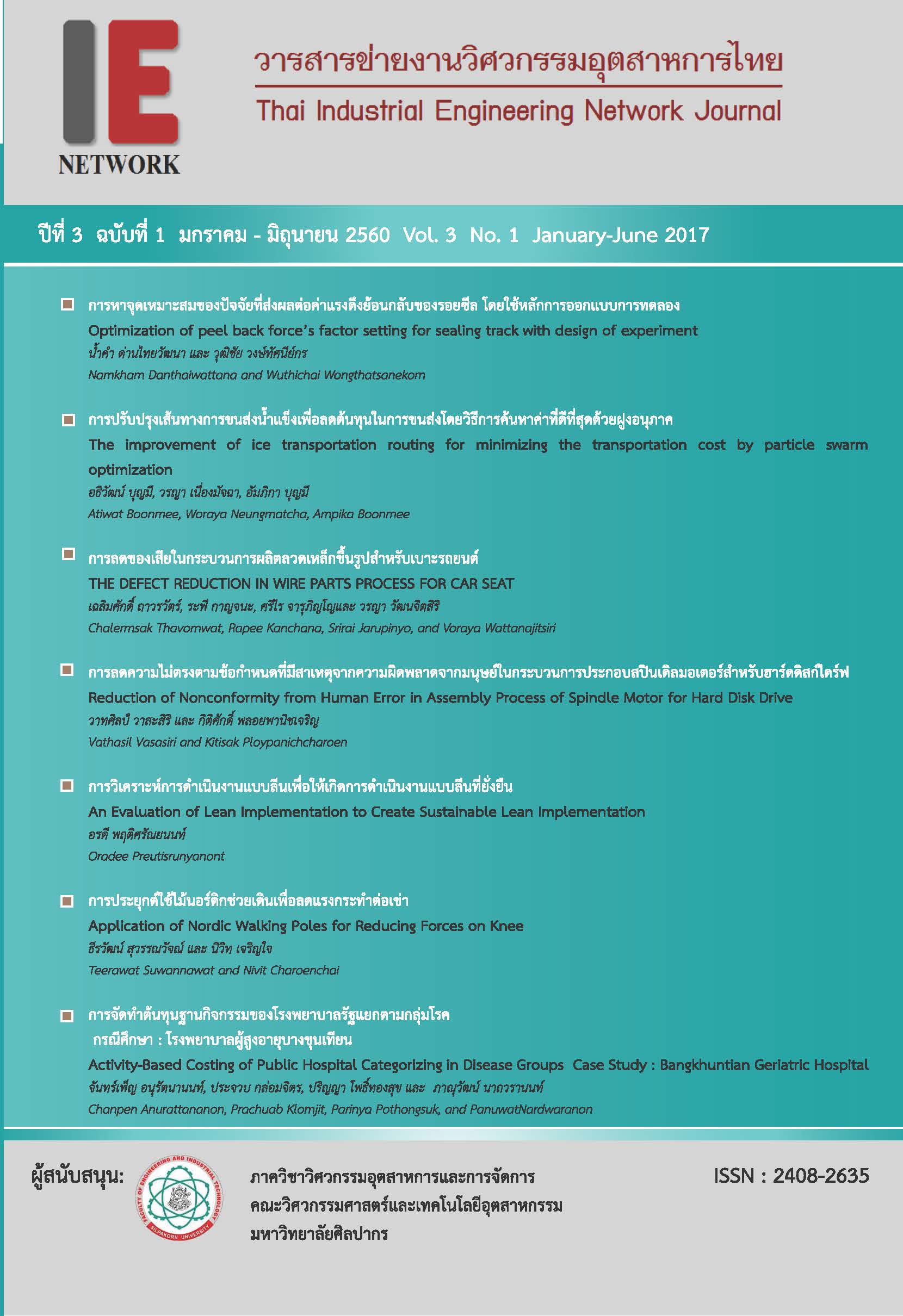THE DEFECT REDUCTION IN WIRE PARTS PROCESS FOR CAR SEAT
Main Article Content
Abstract
This research aimed to reduce a number of defects in wire forming process of car seat production so as to achieve the company’s target at least 20% decrease. From initial study during January to March 2014, it found that at CNC section had the average maximum number of defects with 720.7 kg. Therefore CNC was selected for improvement in this study. During April 2014, data was collected in three processes; wire straightness, wire setup and wire processing, it found the number of defects were 252.1 kg, 134.6 kg, and 72 kg, respectively. The research methodology began with prioritizing the problem by Pareto diagram, then using cause and effect diagram to investigate the causes of the problem and finding the root cause of each problem by why-why analysis. Furthermore, many IE techniques such as design and fabricating inspection tool, visual control were applied to improve work method as well as the linear regression analysis was also used to investigate the relationship among variables. After improvement by fabricating wire straightness checking tool, establishing a standard operation procedure, identifying tolerance standard and spring back value in different physical properties and filing its program properly, the result showed that a total
number of defects at both wire straightness and wire setup processes reduced from 386.7 kg. to 219.9 kg, as of 43.13% improvement.
Article Details
บทความ ข้อมูล เนื้อหา รูปภาพ ฯลฯ ที่ได้รับการตีพิมพ์ในวารสารฯ ถือเป็นลิขสิทธิ์ของวารสารฯ หากบุคคลหรือหน่วยงานใดต้องการนำทั้งหมดหรือส่วนหนึ่งส่วนใดไปเผยแพร่ต่อหรือเพื่อกระทำการใดๆ จะได้รับอนุญาต แต่ห้ามนำไปใช้เพื่่อประโยชน์ทางธุรกิจ และห้ามดัดแปลง
References
[2] ชาญณรงค์ อินทรชู และระพี กาญจนะ. การลดของเสียในกระบวนการขึ้นรูปด้วยความร้อนถาดบรรจุฮาร์ดดิสก์ 2.5” โดยการประยุกต์ใช้เทคนิคการออกแบบการทดลอง. วารสารวิศวกรรมศาสตร์ ราชมงคลธัญบุรี. ปีที่ 11:ฉบับที่ 1: หน้า 37-48
[3] วลัยพร เหมโส และระพี กาญจนะ. การลดของเสียจากกระบวนการผลิตผ้าเบรกรถยนต์โดยประยุกต์ใช้วิธีการ DMAIC. วารสารวิศวกรรมศาสตร์ ราชมงคลธัญบุรี. ปีที่ 11:ฉบับที่ 2: หน้า 33-46.
[4] ปฐมพงษ์ หอมศรี และจักรพรรณ คงธนะ. การลดของเสียในกระบวนการผลิตชิ้นส่วนฉีดพลาสติกสาหรับชิ้นส่วนยานยนต์ โดยใช้หลักการออกแบบการทดลอง. วารสารวิศวกรรมศาสตร์ ราชมงคลธัญบุรี. ปีที่ 12:ฉบับที่ 2: หน้า 11-28.
[5] สุพัฒตรา เกษราพงศ์ ประภาพรรณ เกษราพงศ์ และอวยชัย สลัดทุกข์. การลดของเสียในกระบวนการผลิตชิ้นส่วนท่อไอเสีย
รถจักรยานยนต์. เอกสารสืบเนื่องจากการประชุมวิชาการข่ายงานวิศวกรรมอุตสาหการประจำปี พ.ศ.2555; 17-19 ตุลาคม พ.ศ.2555; โรงแรมเมธาวลัย. เพชรบุรี; 2555. หน้า 150.
[6] อุเทน เฉลยโฉม สุรัตน์ ตรัยวนพงศ์ และระพี กาญจนะ. การเพิ่มประสิทธิภาพการทำงานของเครื่องทอดโดยเทคนิคการบำรุงรักษาเชิงป้องกัน กรณีศึกษาโรงงานอาหารกึ่งสำเร็จรูป. วารสารวิศวกรรมศาสตร์ ราชมงคลธัญบุรี. ปีที่ 13:ฉบับที่ 2: หน้า 21-33.
[7] วชิระ มีทอง. การออกแบบจิ๊กและฟิกซ์เจอร์. พิมพ์ครั้งที่ 22. กรุงเทพฯ: สมาคมส่งเสริมเทคโนโลยี (ไทย-ญี่ปุ่น); 2553.
[8] เจริญ สว่างวงศ์ และสมชาย พัวจินดาเนตร. การลดของเสีย ประเภทโพรงหดตัวจากกระบวนการผลิตไดแคสติ้งแรงดันสูง. เอกสาร
สืบเนื่องจากการประชุมวิชาการข่ายงานวิศวกรรมอุตสาหการประจำปี พ.ศ.2555; 17-19 ตุลาคม พ.ศ.2555; โรงแรมเมธาวลัย. เพชรบุรี; 2555. หน้า 184.


